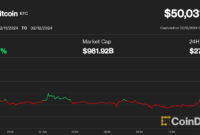Key points
- The Federal Reserve announced its plans to raise the target federal funds rate by 0.75%. That 75 basis point bump will increase the cost of debt and borrowing for consumers and businesses.
- That marks the third consecutive 0.75% rate hike by the Fed to try and slow inflation, which is at a 40-year high.
- At press time, the market capitalization for the entire cryptocurrency sector is up a fraction — 0.17% — to a total of $925.79 billion according to CoinMarketCap.
For the third time in a row, the Federal Reserve announced its intent to raise the short-term interest rate on borrowing by another 0.75%. Many economists were expecting that increase and the financial markets largely baked that calculation into their market cap calculus. It seems the crypto market did the same thing, as the total market capitalization across cryptocurrency exchanges barely flinched. It’s up 0.17% on the news to $925.79 billion for the digital asset sector, according to CoinMarketCap at time of writing.
However, the single largest and most valuable crypto — Bitcoin — was down 1.02% at a price point of $19,321 per coin. This is largely due to the fact that the Fed’s rate hike boosted bond yields as high as 4% and the value of the U.S. dollar strengthened as well, which generally hurts Bitcoin.
What’s the Fed trying to do?
In August, we saw the rate of inflation (compared to the same time last year) surge to a higher-than-expected level of 8.3%. That was the 15th consecutive month of inflation in mid-single digits. That level of sustained inflation has spurred the Fed to push interest rates higher in an effort to slow down the economy.
In the Fed’s statement following its Federal Open Market Committee (FOMC) meeting today, while the central bank patted itself on the back for spurring job growth and low employment — one of its primary remits as an organization — it also admitted that it’s having difficulties with its other responsibility of curbing inflation due to supply chain issues, price pressures, and higher costs for food and energy.
“We are moving our policy stance purposefully to a level that will be sufficiently restrictive to return inflation to 2%,” Fed Chair Jerome Powell said in a press conference immediately following the FOMC meeting.
While Chair Powell did not expressly say how high rates could go before they’re “sufficiently restrictive,” he signaled during the press conference that further rate hikes can be expected from future FOMC meetings, the next of which is in November 2022.
BTC/USDT
Bitcoin recovered from $19,320 on Sept. 16 and rallied above $20,000 on Sept. 17, but the bulls are struggling to sustain the higher levels. This suggests that the bears are active at higher levels.

The 20-day exponential moving average (EMA) of $20,432 has turned down gradually and the relative strength index (RSI) is in the negative zone, suggesting that the sentiment remains negative and traders are selling near overhead resistance levels.
If the price continues lower and breaks below $19,320, the BTC/Tether (USDT) pair could decline to $18,510. Buyers are expected to defend this level with vigor.
On the upside, the 50-day simple moving average (SMA) of $21,605 is the key level to keep an eye on. If the bulls push the price above it, the pair could rally to $25,211. A break and close above this resistance could indicate the start of a new uptrend.

The 4-hour chart shows that the sellers are trying to stall the recovery at the 20-EMA. This indicates that the bears are in no mood to surrender their advantage. If the weakness persists and the price breaks below $19,320, the pair could slide to $18,510.
Conversely, if the price turns up from the current level and breaks above the 20-EMA, the recovery could extend to the 50-SMA. This level may again act as a resistance but if this obstacle is cleared, the next stop could be the 61.8% Fibonacci retracement level of $21,470.
XRP/USDT
Ripple (XRP) has been stuck inside a range between $0.30 and $0.39 for many days. The price has reached the resistance of the range, and if the bulls clear this hurdle, it could signal the start of a new uptrend.

In a range, traders usually buy near the support and sell close to the resistance. If the price turns down sharply from the current level and breaks below the moving averages, it will indicate that the XRP/USDT pair may extend its consolidation for a few more days.
Although the moving averages are crisscrossing each other, the RSI has jumped into positive territory, indicating that the bulls have a slight edge. If buyers drive and sustain the price above $0.39, the pair could rally to $0.48.

The pair rallied sharply from $0.32 to $0.39, indicating strong buying by the bulls. The 20-EMA has turned up and the RSI is in the positive zone, suggesting that the path of least resistance is to the upside.
If the price continues higher and breaks above $0.39, the bullish momentum could pick up and the pair could rally to $0.41. This level may act as a resistance but if buyers flip the $0.39 level into support, the up-move could resume.
LINK/USDT
Chainlink (LINK) has been stuck inside a large range between $5.50 and $9.50 for the past several weeks, indicating that buyers are attempting to form a bottom. The bulls pushed the price above the moving averages and the RSI jumped into positive territory, indicating that the positive momentum could be improving.

There is a minor resistance at $8.30 and if the bulls push the price above it, the LINK/USDT pair could rally to the stiff resistance at $9.50. This level is likely to attract aggressive selling by the bears, but if the bulls pierce through the barrier, it could indicate the start of a new uptrend.
The moving averages are the important support to watch for on the downside because if they give way, the selling pressure may pick up. That could start a decline to $7.00 and thereafter to $6.20.

Buyers are attempting to defend the moving averages on the 4-hour chart. That could start a recovery toward the overhead resistance at $8.20. If the price rises above this overhead resistance, the pair could rally to $9.00.
If bulls fail to push the price above $8.20, the bears may fancy their chances and try to sink the pair below the moving averages. That may tilt the advantage in favor of the bears. The pair could first decline to $7.50 and then to $7.00.
EOS/USDT
The bears pulled EOS below the 50-day SMA of $1.44 on Sept. 15, but they could not break the support at $1.34. This suggests that the bulls are buying on dips and are attempting to form a low near $1.34.

A minor negative is that the bulls are facing strong resistance at the 20-day EMA of $1.50. This indicates that the bears have not given up and are attempting to wrest control. This tussle between the bulls and the bears is likely to resolve with a strong breakout.
If the price breaks above the 20-day EMA, the bullish momentum could pick up and the EOS/USDT pair could rally to $1.86. Alternatively, if the price turns down and breaks below $1.34, the pair could decline to $1.24. A break below this support could sink the pair to $1.00.

The recovery faltered near $1.50, indicating that the bears continue to sell on rallies. The bears will try to further cement their edge by pulling the price below the strong support of $1.34, but that may not be that easy.
Buyers have defended the $1.34 level on three occasions and will again try to do so. If the price rebounds off $1.34, the bulls may again attempt a rally above the overhead resistance of $1.50. If they manage to do that, a rally to $1.70 and later to $1.86 is possible.
XTZ/USDT
Tezos (XTZ) broke below the 20-day EMA of $1.57 on Sept. 13, but the bears could not pull the price to the support line of the symmetrical triangle. This indicates that buyers are accumulating on dips and not waiting for a deeper correction to make an entry. This increases the likelihood of a recovery in the near term.

If the price breaks above the 20-day EMA, the XTZ/USDT pair could rise to the 50-day SMA of $1.66. This level has acted as a strong resistance on two previous occasions; hence it is an important level to keep an eye on. If the bulls overcome this barrier, the pair could attempt a rally to the resistance line of the triangle.
A break above the triangle will signal a potential trend change. The pair could then rise to $2.00 and later to $2.36.
Meanwhile, the bears are likely to have other plans. They will try to stall the recovery at the moving averages. If the price turns down from the current level and slips below the $1.50 to $1.40 support zone, the June low at $1.20 may be revisited.

The 4-hour chart shows that the bulls defended the support at $1.50 and pushed the price above the downtrend line, but they could not sustain the higher levels. If the bears sink the price below $1.50, the pair could decline to $1.40.
On the other hand, if the price rebounds off the $1.50 support once again, it will suggest that lower levels continue to attract buyers. The bulls will then try to push the price above the moving averages and challenge the resistance at $1.62. If this level gives way, the up-move could reach $1.70.



